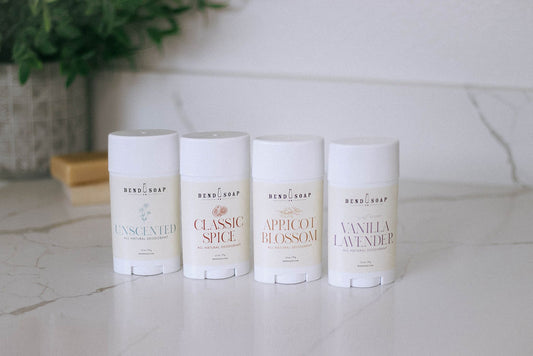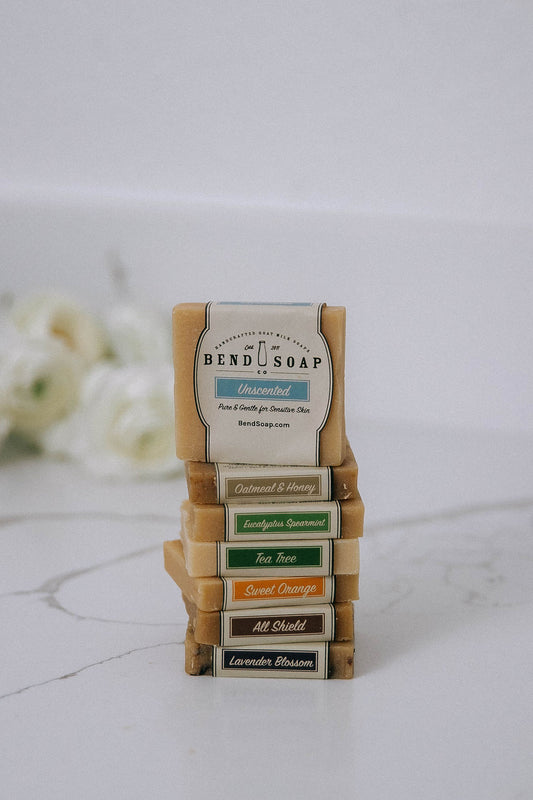Like brushing your teeth and washing your hair, bathing has become such a routine part of our lives that we don’t often pay attention to what’s actually in the soaps and body wash products that we use. But we should.
Traditional soaps are often full of toxic, dangerous chemicals that penetrate the skin and cause serious health conditions, even as they wash away dirt. But with so many options out there, how can you choose the best soap for you and your family?
Knowing what ingredients to avoid is the first step in choosing the right soap, and we’re here to help with that. Take a look at the five most harmful ingredients in traditional soap, plus our pick for soaps to help you get clean with clean ingredients.
Parabens
Parabens are chemicals that are used to preserve cosmetics and personal care products, the same way chemical preservatives are used to keep foods from spoiling while they sit on store shelves. Because widespread paraben use is still a relatively modern occurrence, we don’t have definitive scientific research on how it impacts the body. There is, however, a 2004 study that found traces of intact parabens in the breast tissue of women.
While the study didn’t link the existence of the parabens to an increased incidence of breast cancer, it does reveal the chemicals’ ability to penetrate the skin and remain in the body unaltered by metabolism. Additionally, according to the Environmental Working Group, parabens can “act like the hormone estrogen in the body and disrupt the normal function of hormone systems.”
Fragrance
One of the best ways to avoid products with unsafe ingredients is to check ingredient labels for known toxins. Sometimes, however, that approach doesn’t work. Because the FDA doesn’t require cosmetic manufacturers to list the specific ingredients that are used to create their product’s scent, the word “fragrance” is often a convenient hiding place for some pretty toxic chemicals.
Researchers found that the fragrances of up to 100% of cosmetic products contained known allergens. Phthalates are a group of chemicals that are used as a solvent and fixative in fragrances, and they have been shown to cause damage to the liver, kidneys, lungs, and reproductive system, including the still-developing testes of male babies in utero.
1, 4-Dioxane
Like the compounds that make up your favorite soap’s scent, you probably also won’t find 1, 4-Dioxane on any ingredient labels. 1, 4-Dioxane is found in soaps and other sudsy products, and it is created when common ingredients are mixed together. 1, 4-Dioxane is a byproduct of this process — not a standalone ingredient — which explains why the FDA doesn’t require that it be listed on labels.
The Environmental Working Group (EWG) notes that while 1, 4-Dioxane can easily be removed from products prior to packaging, it remains in up to 46% of personal care products on the market. This is a critical issue, as the EWG considers 1, 4-Dioxane highly hazardous. Even short term exposure to the chemical can cause irritation of the eyes, nose, and throat, as well as kidney and liver disease. Long term exposure can cause cancer, and 1, 4-Dioxane is also known to pass through a mother’s breast milk.
Sodium Lauryl Sulfate (SLS)
Whether they’re washing their hands or their body, many people equate the efficacy of soap to the amount of lather it generates. Unfortunately, all of those suds come at a cost. Sodium Lauryl Sulfate, also known as SLS, is the ingredient added to soap to make it lather, and according to the EWG’s Cosmetics Database, it’s highly toxic. SLS carries a high concern for irritation of the skin, eyes, and lungs, as well as moderate concern for organ system toxicity.
Triclosan
In September 2016, the FDA banned triclosan, an antibacterial and antifungal ingredient used as a preservative in personal care products. The chemical has been found to negatively impact the immune system and cardiovascular function, while also potentially triggering an increase in allergy and asthma symptoms, antibiotic and antimicrobial resistance, and lower testosterone levels (to only name a few side effects).
Unfortunately, the FDA ban didn’t eliminate these risks. The ingredients found in antibacterial soaps place the products in the same category as over-the-counter drugs, so antibacterial soaps are regulated by the FDA. Traditional soaps, however, are not.
Even after the antibacterial soap ban on triclosan, it is still found in 2,000 or more products. And because of its frequent use in personal care products, research estimates that up to 75% of Americans are currently exposed to this dangerous chemical.
The Best Safe, All-Natural Soap
At Bend Soap Company, we craft all-natural, hypoallergenic soaps that are free of toxic ingredients but also completely effective in delivering a deep, moisturizing clean.
Our original Unscented Goat Milk Soap is made with just four ingredients: fresh goat milk, coconut oil, olive oil, and sustainably sourced red palm oil. These ingredients nourish the skin with vitamins and minerals leaving it soft and supple with no danger of irritation or worse. It’s even safe for newborns!
We also have more than a dozen scented varieties that are free of dangerous, mysterious “fragrances.” Instead, they’re made with high-quality essential oils like geranium rose, tea tree, and lavender.
Back to You
Lathering up in the bath or shower shouldn’t put you at risk for harmful health conditions like skin rashes or eye irritation. Ditch the traditional soaps that are filled with “dirty” ingredients like parabens, SLS, and triclosan, and opt, instead, for a more natural option. Goat milk soap provides a deep clean that will also leave your skin soft, supple, and nourished.
Continue Reading
- Blog Post: How to Live a Healthy, Toxin-Free Life
- Blog Post: The Hidden Dangers of Bath Bombs You Need to Know
- Blog Post Using Goat Milk Soap as Face Wash
- Blog Post: Your Exfoliating Face Wash is Doing More Harm Than Good
- Blog Post: Must-Have Skincare Products for Newborns





103 comments
Hi Charlotte,
Thanks so much for reaching out to us about this. These are great questions. Not all soaps contain borax or even a borax substitute. Most soaps, including our goat milk soaps, are primarily made from fats or oils combined with an alkali, like sodium hydroxide or also known as lye to create solid soaps.
Here’s what we know about borax:
Borax, also known as sodium borate, sodium tetraborate, or disodium tetraborate, is a naturally occurring mineral and a salt of boric acid. Its chemical formula is Na₂B₄O₇·10H₂O. Borax is commonly found in dry lake beds in regions such as Turkey, the United States (notably California’s Death Valley), and Tibet.
*Properties of Borax
Appearance: It typically appears as a white powder or as colorless crystals.
Solubility: Borax is soluble in water.
pH: It has a mildly alkaline pH when dissolved in water, which makes it useful in a variety of cleaning and laundry applications.
*Uses of Borax
Cleaning Agent: Borax is a component of many detergents and cleaning products due to its ability to soften water, enhance the cleaning power of soaps and detergents, and disinfect surfaces.
Laundry Booster: It is often used as a laundry additive to boost the effectiveness of detergents.
Pest Control: While not commonly used in commercial rat poisons today, it has been used in the past for homemade rodent poison recipes as it is toxic to rodents in sufficient quantities. It can also be used in homemade ant and cockroach bait because it is toxic to many insects.
DIY Crafts: Borax is used in making slime and other craft projects because it acts as a cross-linker for the polymer chains in glue.
Water Treatment: It can be used to control the alkalinity of water in swimming pools and water treatment processes.
Preservative: Borax has applications in preserving certain foods and cosmetics, although its use is restricted or banned in some countries for food products.
In response to your question about ammonia producing bubbles the answer is that products containing ammonia technically can produce bubbles. However, it’s not the ammonia itself that causes the bubbles. In order to get bubbles with products containing ammonia, it has to be mixed with certain surfactants such as those found in soaps or detergents, to create a solution that produces bubbles. Surfactants are compounds that reduce the surface tension of a liquid. When surfactants are present, they lower the surface tension of water, making it easier for bubbles to form.
Our soaps are not made with ammonia.
We hope that you find this informative. If you have any further questions or concerns, please don’t hesitate to ask. We are always here to help!
I thought all soap had a borax substitute in it? Rat poison. Correct? I could be wrong. I don’t think it’s right though. Couldn’t low amounts of ammonia produce bubbles?
In addition to the ingredients listed, coconut oil is especially comedogenic (pore clogging) for sensitive and acne-probe skin and can actually worsen acne in certain individuals. Just a tip from experience.
This is very informative, and also anxiety provoking. If an ingredient is a by-product if mixing other ingredients, we can’t know if it’s in there or not. Also, while I can control what I use at home, there is still a need to wash our hands in public places where we can’t control what type of soap is available, and it’s not practical to carry around our own soap. It’s frustrating that chemicals banned in other countries (supposedly) are still widely used in the US, despite having government agencies that are supposed to be in the business of protecting us. I’m sure it’s all in the name of making more money.
Great information!